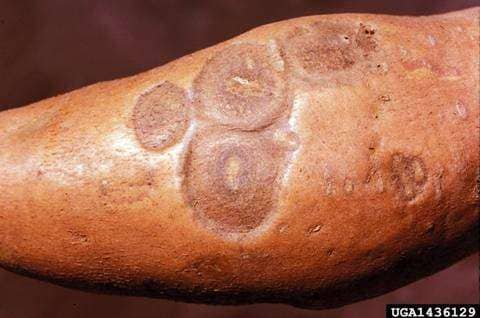This post may contain affiliate links. As an Amazon Associate we earn from qualifying purchases.
What ails your sweet potato? If you think it has one of the more common sweet potato diseases, read on to figure out how to treat it.
The sweet potato vine (Ipomoea batatas) is a South American tropical plant that requires a minimum of 150 frost-free days to develop.
The ideal average temperature for growing the sweet potato vine is 75 degrees Fahrenheit. It is neither drought nor flood-tolerant.
Sweet potato vines are generally not troubled by pests but there are several common sweet potato diseases that the grower should be aware of.
By the way, did you know growing sweet potatoes in a container is super easy? Check out our blog post, here.
Streptomyces Soil Rot Sweet Potato Disease
Streptomyces soil rot is a soilborne sweet potato disease, as opposed to a disease carried in the air or in water. Also known as pox, this disease is caused by Streptomyces ipomoea, which rots the feeder roots, causing a reduction in yield.
The disease commonly attacks sweet potato vines that are grown in dry soils with a pH over 5.2. Symptoms of Streptomyces soil rot include stunted and yellow foliage and sweet potato vines that don’t produce.
According to Dr. Chris Clark, professor of plant pathology at Louisiana State University, the ‘Jewel’ sweet potato variety is highly susceptible to streptomyces soil rot while ‘Beauregard’ and ‘Hernandez’ are resistant.
Prevention of pox includes choosing soils that are a bit heavier, lots of irrigation early in the season and growing a resistant variety.
Professional growers apply a soil fumigant before planting. Home growers should plant the resistant varieties mentioned earlier.

Southern Blight and Circular Spot
Sclerotial blight, also known as stem rot or southern blight, is another soilborne sweet potato disease caused by a fungus, Sclerotium rolfsii. Symptoms of sclerotial blight include discoloring, wilting and death of foliage and, eventually, the death of the sweet potato vine.
A white fungus can sometimes be seen on the soil around the base of the sweet potato vine, especially during periods of high humidity.
Management of this disease is preventive in nature: Plant resistant varieties (‘Beauregard’ or ‘Evangeline’) and bury the seed 8-inches deep, where the fungus can’t survive.
Circular spot is caused by the same fungus, S. rolfsii, that causes sclerotial blight, but it attacks at a different stage of sweet potato development. Circular spot develops just prior to harvest, in hot weather, and attacks storage roots.
The disease produces circular lesions on the sweet potato which may peel off after harvest. There is no treatment for circular spot.
Root-knot Nematode
Root-knot nematode, Meloidogyne spp., is a widespread and destructive sweet potato disease. A small roundworm with the thickness of a piece of thread, the nematode is a parasite that feeds on the sweet potatoes’ roots.
It prefers sandy soils and attacks both the feeder and the storage roots, causing cracks in the sweet potatoes. These cracks provide an entrance for fungi that will rot the tuber.
Agents with the Maryland Cooperative Extension suggest purchasing varieties that have shown resistance to root-knot nematodes in your region; use good, organic soil amendments when preparing the soil; and water and fertilize consistently to keep the sweet potato vine strong.
Contact your local Cooperative Extension office to find out which varieties are most resistant. You’ll find a directory here.





